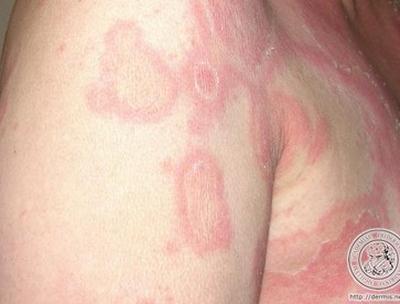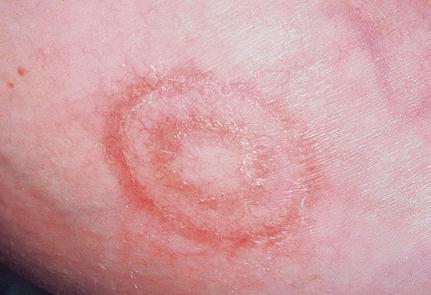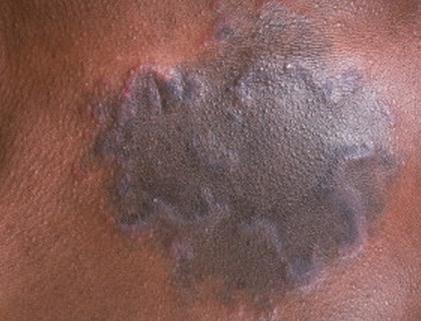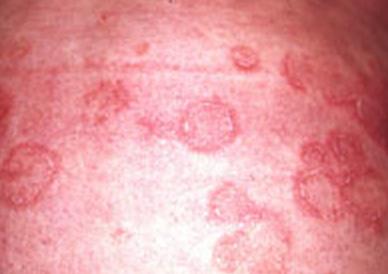Erythema Annulare Centrifugum
Whay is Erythema Annulare Centrifugum?
Erythema annulare centrifugum is a term used to describe skin lesions. It was first described by Darier in 1961 and is characterized as nonpruritic, scaling or nonscaling, red in color, ring form or can be curved. Lesions spread from the center and may may last from a few days to a few months. Other names for Erythema annulare centrifigum are”deep gyrate erythema,” “Erythema perstans,” “Palpable migrating erythema”, and “superficial gyrate erythema.”
Lesions usually begin as a small pink to red spot, ultimately becoming bigger at a rate of about two to five millimeters per day and extend up to six to eight centimeters. Lesions form in a ring shape while its central area flattens and clears. Sometimes they grow into irregular shape. Eruptions start to appear on the thighs and legs but may also appear on the face, chest and upper extremeties. EAC is usually without symptoms but sometimes mild itching is experience by the patient. It is considered as rare disease, affecting one in 100,000 per year.

Causes
According to studies, Erythema annulare centrifugum has been linked with different etiologic factors. Erythema annulare centrifugum is also associated with underlying diseases and conditions. These include:
Bacterial, fungal, filarial and viral infections
Example of these are tuberculosis, sinusitis, lyme disease, candidiasis or tinea.
Medications
Hypersensitive reactions to a variety of drugs such as antimalarials (chloroquine and hydroxychloroquine), aldactone, oestrogen, penicillin and amitriptyline.
Cancer
Carcinoma, blood dyscrasias
Food
Ingestion of blue cheese or tomatoes
- Ascaris Infestation
- Arthropod bites
- Pregnancy
- Hormones
- Idiopathic or an unknown cause
- Other diseases such as recurrent or chronic appendicitis, cholestatic liver disease (blocked bile system), and Graves disease (overactive thyroid gland) and autoimmune disorders like Lupus.
Histopathology
In classic or deep cutting in the middle and lower dermis, an intense, superficial and deep lymphocytic or lymphohistiocytic perivascular infiltrate in a coat-sleeve fashion. While the superficial type, the presence of more nonspecific perivascular lymphohistiocytic infiltrate the superficial dermal vessels and edema of the papillary dermis is noted.
A study made by medical practitioners revealed the substantial differences between cases with a wholly superficial type and cases with a superficial and deep infiltrate. Clinically, a collarette of scales was seen only in the superficial type. Histopathologically, some findings were much more common in the superficial type (eg, spongiosis, parakeratosis, crusts, edema of the papillary dermis, epidermal hyperplasia) and in the deep type (eg, sleeve-like arrangement of the infiltrate, melanophages, subtle vacuolar changes at the dermo-epidermal junction, individual necrotic keratinocytes). Whereas cases of the superficial type could be distinguished from differential diagnoses by a variety of clinical and histopathologic findings, most cases of the deep type showed subtle signs of lupus erythematosus. Neither type was associated consistently with any other systemic disease. Because the superficial and the deep type of erythema annulare centrifugum seem to be unrelated to one another, they should not be referred to by the same name.
Treatment
EAC is usually self-limiting, ie. it clears up by itself. Determining the appropriate treatment and ruling out underlying disorders is the primary therapy.
Topical steroids
Used to relieve swelling, redness and itchiness. However, topical steroids are not proven to be effective to prevent the occurrence of new lesions.
Injection steroid therapy
Effective in reducing inflammation, but recurrence of lesions happen after stopping the therapy.
Topical calcipotriol
A topical vitamin D derivative has been known to be beneficial.
ICD-9 Code
The International Statistical Classification of Diseases and Related Health Problems or ICD is a system published by World Health Organization (WHO) that provide codes in which every health condition is assigned to unique category. ICD is used worldwide to classify diseases and different kinds of signs and symptoms, abnormal findings, physical assessment, social circumstances, and external causes of injury or disease. ICD is also use to determine the morbidity and mortality percentage.
Erythema Annulare Centrifugum
L53.1 is a billable ICD-10-CM code that can be used to specify a diagnosis.
ICD-10-CM will officially replace ICD-9-CM on October 1, 2013, therefore, L53.1 and all ICD-10-CM diagnosis codes should only be used for training or planning purposes until then.
Is Erythema Annulare Centrifigum Contagious?
At present, EAC is not known to be contagious. No studies have been proven that EAC is contagious.
Erythema Annulare Centrifugum pictures
photos, pics, images of Erythema Annulare Centrifugum


